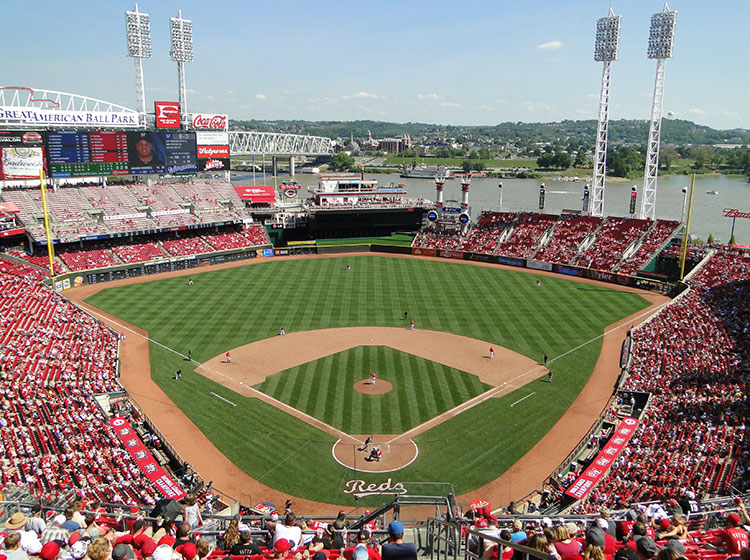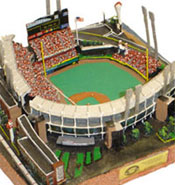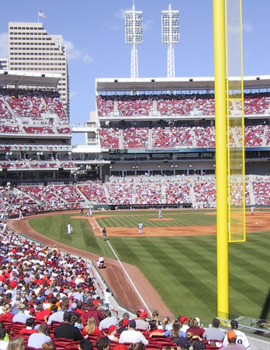
|
America’s pastime first planted its professional roots in Cincinnati when the Reds (then called the Red Stockings) began play in 1869. So it seems appropriate that something called the Great American Ball Park would spring up in The Queen City.
Alas, when Cincinnati’s new ballpark opened for the 2003 season it was courtesy of the Great American Insurance Company, who ponied up $2.5 million per year through 2033 for the aptly titled replacement to Cinergy Field, which was imploded three months prior to Great American Ball Park's inaugural opening day. Built on the banks of the Ohio River on the downtown Cincinnati riverfront, Great American Ball Park (GABP for short) lacks the jaw-dropping panoramic views you get at Pittsburgh PNC Park, which is the gold standard of retro riverfront ballparks. So instead of the downtown Cincy skyline, from the upper deck seats you get an eyeful of the homes and other small structures that dot the Kentucky side of the Ohio River. The focal point of the ballpark’s backdrop is the Taylor-Southgate Bridge, a rather unassuming white steel of an expanse built in 1995 to connect Newport, Kentucky and Cincinnati. The bridge can be summed up by the unaffiliated Cincinnati-Transit.net website: “While not an eyesore, the city missed an opportunity to build an outstanding new bridge in a high profile location.” The Ball Park’s signature architectural feature is the “gap.” In this case, addition by subtraction works wonders, as the designers of GABP decided to create a lowered split-level upper deck on the third base side of the field and separate it 35 feet from the main single tiered upper deck.
Speaking of heights, the distance from the last row of the upper deck to home plate is 259' 7," and when I visited the uppermost reaches of the ballpark I was surprised at how far away from the playing field it really felt. I was also surprised at the poor sightlines from the upper deck beyond the first base bag, as an alarming amount of fair territory down the outfield line extending to the right field foul pole is obscured from the seats there, even though they are among the 20% of seating within GABP that is angled 12 degrees towards home plate GABP features an enormous 218’ wide scoreboard that spans the length of the left field bleachers and provides fans with both teams’ lineups, a full array of statistics, a message board and video screen. Atop the eastern portion of the scoreboard stands an analog clock that was modeled after the primary Longines timepiece once in use at Crosley Field. Much like Cleveland’s Progressive Field, GABP has an out-of-town scoreboard embedded into the left field wall. Unfortunately, fans sitting behind that wall can’t see the impressive main scoreboard above them, and have only a miniature score-only board to view from their seats. The Reds also decided to install mini-video boards (commonly referred to as ribbon boards and most often seen wrapping around arenas) along the façade of each upper deck, where they serve little purpose other than displaying animated ads for Pepsi and other sponsors. Although rumors abounded that the Reds would scrap the ads on the first base side ribbon boards in favor of giving left field patrons the line score and other stats that they are missing, I haven’t been back to GABP since the next-to-last game of its inaugural season to verify if that plan ever came to fruition. Straight-away center field is the resting place of the Batter’s Eye Pavilion, a scaled down replica of the likewise pine green colored private structure of the same name at Tampa Bay’s Tropicana Field (which has since been painted blue). Cincinnati’s version wouldn’t be all that noticeable, but a can't-miss, 7,500-square-foot riverboat-themed rooftop deck was built atop it after the 2006 season. Additionally, there is a two-level fan concourse located next to the Batter’s Eye, and although the entire playing field isn’t visible it’s still a nice place to briefly hang out and chat with other fans. On the right field side of the Batter’s Eye are two replica smoke stacks that puff smoke whenever a Reds pitcher records a strike out or spew fireworks following a Cincy homer and victory. Next to the stacks are the right field seats, which rise slightly in overall height the closer they get to the foul pole. These seats offer the best view of the Cincinnati skyline located to the left of home plate. On TV they also look deceptively close to the Ohio River, but in reality it would take a 580-foot poke to reach water. The Reds created what they call a “Sun/Moon Deck” in right field, which is the best place to watch the game if you want to stand, but the security personnel keep you back a few feet from the railing. On the other hand, fans can get a good view of the bullpens from the outfield concourse while leaning against white steel bars. The Reds’ new ballpark does pay homage to one of their previous homes, Crosley Field (1912-70), with the Crosley Terrace plaza near the main entrance the most impressive reminder of Cincinnati's ballpark during baseball's so-called Golden Age. But notably absent is any real reference to Riverfront Stadium, which was renamed Cinergy Field in September of 1996. Perhaps the most unique, but hidden feature of the still fairly new yard is the string of quotes that wrap around the interior of the club level concourse, visible from the wide concourse behind the third base grandstand. Among the famous words are Casey Stengel’s “I don’t like them fellas who drive in two runs and let in three.” There’s no doubt Cincinnati is a baseball city – in 2003 a public arts exhibit called Bats Incredible! featured 11,000 regulation sized Louisville Slugger bats that were turned into 250 baseball themed sculptures and placed throughout downtown - but there isn’t a whole lot going on in the city on weekends, when the majority of nearby restaurants are closed. So a walk across the Taylor-Southgate Bridge to Kentucky, where a hub of activity centers around a mall, movie theatre and the Newport Aquarium, may be in order for out-of-towners. The walk from GABP to Kentucky takes about 15 minutes and offers the best glimpse of the ballpark and the entire Cincinnati skyline. From the bridge you get a good view of U.S. Bank Arena, which is located next door to GABP, and not too much further down the Ohio River stands the sleekly designed Paul Brown Stadium, home of the NFL’s Cincinnati Bengals. While Cincinnati has professional sports, the Northern Kentucky side of the Ohio River is home to much more than food and entertainment. The Cincinnati/Northern Kentucky International Airport is located in Covington, 13 miles across the border, and the ballpark is easily accessible from there by public bus via the drop-off point of 4th and Main after a mere 25-minute ride on the TANK (Transit Authority of Northern Kentucky) #2X Airport Express for the paltry sum of $1.75. While at the airport, or any place else you can find it (including the GABP Skyline Chili concession), I highly recommend that you scarf down a bowl of Cincinnati’s delightful chili. Although the baseball team has fallen on hard times, I dare say that the city’s famous recipe for chili makes the losing easier to stomach. Despite some shortcomings, Cincinnati has a nice ballpark, but I’d rate it Good over Great, although it has been improved since it's first season, after which the second and final phase of construction added a Reds Hall of Fame & Museum building and a (Pete) Rose Garden to the western edge of ballpark property. But the bottom line is that my strong initial impression of GABP faded, much like the 2003 Reds (who started 34-32 but finished 69-93), over the course of my visit. Cincinnati has a gritty, working class feel to it, and while the ballpark lacks the overall splendor I’d expect due to its age and location, it does fit right in with the present day Cincinnati image.

Great American Ball Park Facts, Figures, Firsts & Footnotes
| |||||||||||||||||||||||||||||||||||||||


 This separation takes place almost directly behind home plate (if you view it down the right field line) and from a distance the two decks appear to be connected by a walkway. In reality, the upper deck concourse remains exposed due to the lack of seats, but the “gap” itself remains a striking feature and allows for an unobstructed view of the tallest buildings in downtown.
This separation takes place almost directly behind home plate (if you view it down the right field line) and from a distance the two decks appear to be connected by a walkway. In reality, the upper deck concourse remains exposed due to the lack of seats, but the “gap” itself remains a striking feature and allows for an unobstructed view of the tallest buildings in downtown.
